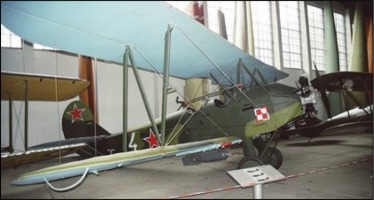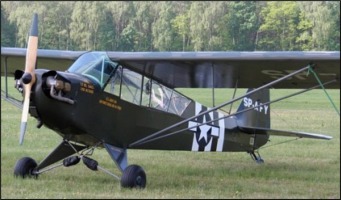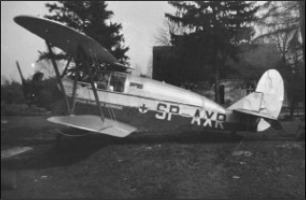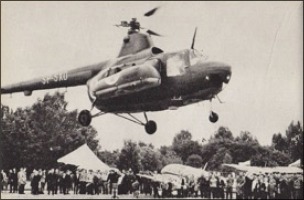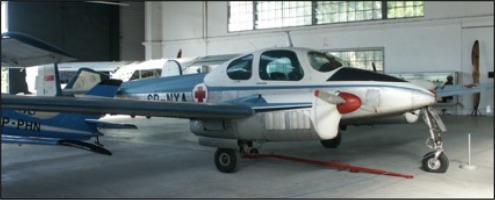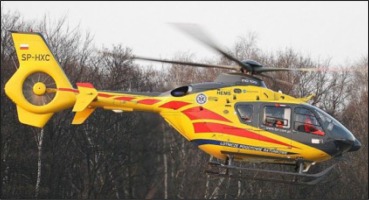Introduction
The basic purpose of modern sanitary rescue is prompt assistance in of the event of an emergency. Aviation Medical Rescue (LPR) in Poland is a unit that performs rescue missions including air transport. The main task of LPR is to ensure medical rescue for each person in life threatening conditions in the shortest possible time. Apart from medical rescue operations, that is flights to accidents and health emergencies as well as helping the victims, LPR operates sanitary transport flights of patients requiring medical aid and sanitary flights of Polish citizens who have had accidents or became sick outside the country’s borders.
The aim of the research is to examine the history of sanitary aviation in post-war Poland. The field of research is medical security from a historical perspective. The following questions were asked in order to fulfil this task:
how did sanitary aviation develop in Poland in the post-war period?
What was the impact of world sanitary aviation on the development of LPR?
The adopted time frame for the research was 1945-2018. In the course of the research, the following theoretical research methods were used: analysis, synthesis, abstraction and generalisation. The work is a continuation of the earlier published material by the author (Rezner 2018).
Restoration and development of sanitary aviation in post-war Poland
During World War II, Polish pilots were dispersed around the world. Many of them were killed in air fights, bombardments or transport flights. After the end of the war, soldiers and pilots returned to Poland but many of them were imprisoned as traitors of the socialist homeland. Under such conditions, the restoration of aviation formation including sanitary aviation was very difficult.
The first sanitary unit in liberated Poland was the 12th Independent Regiment of Sanitary Aviation commanded by Lieutenant Colonel Fiodor Pietrow [after the war, the majority of officers in the Polish Army came from the Soviet Union]. The unit was formed based on the Soviet 141 Regiment of Sanitary Aviation, stationed in Wólka Leszczyńska near Leszno and subordinated to the head of health Service of the Polish Army on 18th December 1944. The Regiment had 32 type PO-2S planes (Fig. 1) as its permanent equipment.
The regiment tasks included evacuation of wounded soldiers of the Ist Polish Army and delivery of medication for field hospitals. In the first month of its operations, the unit made 278 transport flights of soldiers in need of hospitalisation. It is worth mentioning that the 12th Independent Regiment of Sanitary Aviation was engaged in operation berlin. In 1307 air operations, the pilots transported 1297 wounded. The soldiers of the 2nd Polish Army were mainly transported to Poznań hospitals. On 15 july 1945, according to the decision of General Pilot Fiodor Połonin, the Commander of the Polish Army Air Force, the 12th Independent Regiment of Sanitary Aviation was dissolved. At that time, the need for restoration of pre-war sanitary aviation was not recognised. Despite huge needs, the decision was made to transfer most aircraft to other units. The remaining ones served as training or transport planes after the rescue pods were dismantled (bartnik 2015).
In late 1940s, a first effort was made to recreate sanitary aviation. It was prompted by the very poor condition of roads which often prevented medical staff from arriving on time. Moreover, there were more and more German planes taken over and machines acquired after demobilisation or retrieved from abroad. Due to aeroclubs being restored under the auspices of the Aviation League, later taken over by the Soldiers Friends League, the pilots returning from the war and young flying novices started to be trained using accessible types of aircraft. The civil aviation environment took the leading role in air rescue operations. The first after-war civil School of Pilots and Mechanics was opened in Ligota Dolna, Strzelce Opolskie district following the decision of the Ministry of transport in june 1946. The veterans of Polish aviation became the hub of the school staff. Colonel Zenon Romanowski became its first commander. The post was later taken over by Major edmund Surmasiewicz. training took place at three week courses during which the students were taught the basics of take-offs and landings and short flights in a circle on PO-2 planes. There were 90 pilots trained in three training courses between june 1946 and late 1947. The name of the school was changed to Centre for training Pilots and Mechanics of Common Organisation „Service to Poland” (Sławiński 1974).
Due to such initiatives, recreation and construction of a new system of sanitary aviation started. Its seminal figures were people connected with medicine, mostly paediatricians who recommended sudden changes of pressure caused by flying to children sick with whooping cough. Performance of this type of task did not require any alterations to aircraft. A little patient was fastened in the cabin (often with a parent inside, too) and relatively quickly the maximum possible altitude was reached (2500-3000 m). After a short flight at this altitude, the altitude was abandoned just as quickly. The flight took place over the airfield and lasted 30-50 minutes on average). The pilots were very willing to help the little ones to fight the sickness (Gałązkowski and Kłosiński 2005). The planes were also used, apart from helping whooping cough patients, for sanitary transport flights such as carrying anti tuberculosis vaccines-bCG. Such missions were carried out by tadeusz Więckowski, creator of Polish Sanitary Aviation in post-war Poland, on the Warszawa-Częstochowa-Warszawa route. The limited possibilities of aircraft mostly unadapted for transporting wounded, led to the decision makers of the time undertaking steps to adapt airplanes which were part of civil organisations equipment. The task was to be done by workshops of the Civil School of Pilots and Mechanics in 1948. Owing to the funds of the Polish Red Cross collected during the fundraising action, Polish engineers and mechanics modernised a Soviet PO-2 plane changing it into a sanitary version. It was the first Polish medical airplane. „The airframe modernised in this way had registration SP-AFC and became the first aeroclub sanitary plane in early 1950. It was based on Kraków Aeroclub airfield (from where it was sent and returned from modernisation on 3rd December 1949). Its first pilot was Waldemar Pabian” (Gałązkowski and Kłosiński 2005). Following the example of Kraków Aeroclub, other aeroclubs started to undertake sanitary missions. however, the negative approach of the decision makers of the time, lack of funds and legal solutions for carrying out and financing the missions put an obstacle to the development of sanitary aviation.
At the end of 1946, because of a lack of planes, the Ministry of transport decided to buy 300 PIPeR L-4 “CUb” planes. (Fig.2) and 50 StINSON L-5 “Sentinel”. The Polish delegation reached the depot of demobillised equipment encoded as A_50 hawkey. “Finally it appeared that we received fewer airplanes than we had hoped for earlier” according to Zbigniew Luranc and 1414 PIPeR L- planes and 1 taylorcraft L-2A were bought, while the offered Stinson L-5 planes were not accepted (Luranc 1991).
The first railway transport of purchased machines left for Poland on 6.01.1947 and the second one (60 planes) on 2.03.1947, one airplane type Piper L-4h was brought by air (Kempski 1989) The information is incompatible because the same story is described by A. Morgała in a different way. According to him, the first Piper L-4h was brought by air and later, in late january 1947, a subsequent batch of 64 planes arrived by rail. On 11.03.1947, 66 planes were delivered and the whole delivery was completed in this way. In total, 130 planes were brought to Poland (Morgała 1980).
The Piper planes were bought in 4 versions: L-4A, L-4b, L-4h, and L4j and all of them required modernisation. Restoration work was done in the District Aviation Repair Shop in Gdańsk, the District Aviation Repair Shop in bydgoszcz, District Aviation Repair Shop in Poznań, and Aviation experimental Workshop in Łódź. In the Institute of Gliding in bielsk 13, Piper L-4 airplanes were restored. between 1947 and 1950, they were successively registered in the Polish Register of civil aircraft. According to b. Kempski, 127 Piper L-4 aircraft were passed for use in specific versions L-4A (24 units), L-4b (34 units), L-4h (34 units), and L-4j (26 units) According to M Krzyżan 120 planes were passed for use. A. Morgała in turn states that there were 121 planes, but Z. Luranc calculates that there were around 100 PIPeR CUb planes and PO-2 planes were had standard late 1940s equipment of regional aeroclubs of the Aviation League (Luranc 1991).
In 1951, based on an adapted design by engineer tadeusz Chyliński, the Piper CUb SPARF plane was remodelled into a sanitary version in the National Institute of Aviation (Krzyżan 1983). On 11th December 1950, the prototype of a medical version was test flown and in the District Aviation Workshop in Gdańsk, 14 PIPeR planes were adapted into sanitary versions in 1952 which were exploited until 1955 in 13 large voivodship cities (Luranc 1997) because of a lack of spare parts, many planes were cancelled and replacement parts coming from the Soviet bloc, e.g., Czech engines, did not secure the safety of pilots and passengers. In time, American planes were replaced by domestic production on Soviet licence CSS-13. The replacement of PIPeRs was also a political decision. Therefore, at the beginning of the 1950s, a sanitary version of CSS S-13 was created applicable to the needs of sanitary aviation (Fig. 3).
Technical documentation took place in the Institute of Aviation in 1953 under the supervision of engineer tadeusz Sołtyk. The stretchers for the transport of the sick were placed on the ridge of the hull lattice, covered by a lid on hinges and opened on the side. The lid with the glazed limousine was one unit and was to protect the pilot and the doctor. The test flight of the prototype remodelled from mass produced CSS-13 took place on 6th October 1953. There were problems with the longitudinal instability of the plane and the design was subject to construction corrections in the construction office WSK Okęcie by the team of Stanisław Lassota and then sent to mass production. According to M. Krzyżan the first 26 planes were produced in 1954 and next 28 in 1955. The production of these new CSS S13 was completed in WSK Okęcie in August 1955 with 55 planes in total (Krzyżan 1983). however, according to A. Glass, between 1954-1955 in WSK no.4 Okęcie, there were 59 CSS S13 machines built in total (Glass 1980) with 50 new ones produced including six CSS 13 and three from PO 2. One untypical model, S 13, was built as well, with three open cabins for transporting the sick in a sitting position. Of 59 aircraft, 40 were transferred to the Military forces while the remaining 19 were purchased by civil aviation in 1955 (Glass 1980).
While considering the further needs of civil aviation for sanitary planes, the decision was made to rebuild the next CSS 13 into CSS 13 S 13. The remodelling of 38 planes, including two from original Soviet PO 2 planes was commissioned to The Plant of Sports Aviation equipment no. 3 in Poznań. CSS S 13 military planes were used for military forces requirements between 1954 and the end of 1958. between 1956 and 1958, military forces delivered 37 CSS 13 S 13 for the Ministry of health. In total, civil aviation possessed 56 S 13 used for the transport of the sick until 1965. Single aircraft of that type were still flying in the 1970s (Krzyżan 1983).
The above mentioned tadeusz Więckowski – the former AK soldier who was the first to make sanitary flights in post-war Poland was persecuted by the totalitarian political system; his pilot licence was revoked and he was not allowed to practise his profession. In spite of the great injustice which he sufferred, Więckowski did not give up his passion and decided to actively help restore Poland `s sanitary aviation. In 1953, having received no reply from the Ministry of health to his appeal for organisation of sanitary aviation, Więckowski published an article about the problem in “Skrzydlata Polska” magazine which was an appeal to the authorities of the time. Soon after he started to work in the Voivodship emergency Station in Katowice. After the conference called in the Ministry of health, Więckowski received the “green light” to commence Polish sanitary aviation.
The organisational plan confirmed in 1955 envisaged creating the first medical aviation teams in Poland. The Ministry of health transferred money for the purchase of the first batch of the above mentioned S13 planes. The organisational plans provided for creation of a sanitary aviation post in every voivodship as a unit incorporated into the structure of Voivodship emergency Units. In this way, creation of additional institutions incurring costs from the state budget was avoided. however, the nature of the airborne service required the creation of separate regulations for flying ambulances. At the end of 1955, the first units started to appear in Warsaw, Kraków, bydgoszcz, and later in Poznań, Łódź, Kielce, and Katowice. The assessment of the initial work of these teams was promising, so the decision was made to develop the system across the whole of Poland. The fast development of posts quickly revealed the lack of equipment. The insufficient number of planes was already noticeable in the first year of operation of aviation rescue teams. The fleet complementation, as mentioned before, by the transfer of aircraft from military forces was nevertheless insufficient. There were also problems with exploitation and the need for more and more distant routes for which S 13 was too slow compared to expectations. budget deficit and problems related to rebuilding the country put the Ministry in a difficult situation (Morgała 2007).
Therefore, cheaper solutions were sought. Among others through the purchase of second hand equipment. The sanitary fleet was supplemented with the above mentioned Piper Cub L-4, salvaged despite a lack of spare parts, and Fiesler 156 Storch planes which remained from the German Army. The latter were only withdrawn in September 1963 (Cebulok 1996). Other machines such as Focke Wolf FW-58 Weihe, after six year service in the Polish Army, were for a short time in WSK Mielec, where they were remodelled into a flying ambulance and commissioned to the Ministry of health. bucker bu-181 bestman, in turn, was stationed in the Central Station of Sanitary Aviation in Gocław until May 1955 and ended its sanitary aviation service in 1959 (Morgała 2007). At the beginning of 1957, PLL LOt commissioned two Aero-45 machines which proved themselves in sanitary flights. Therefore, the decision was made to purchase several Aero Ae-45 Super Aero machines which served in sanitary aviation until 1978 (Krzyżan 1983).
Helicopters in the service of sanitary aviation
I Polish engineers and mechanics were trained in WSK Swidnik plant and the production line of the first in Poland SM-1 helicopter on a Soviet licence was opened in 1955 (Fig 4).
The test flight of the first SM -1 helicopter produced in a Polish plant took place on 23.03.1956 by the test pilot Wsiewołod Winnicki. Initially, helicopters were only assembled, but since 1957 their production from basics started. The engines earlier imported from the Soviet Union were now produced in WSK Rzeszów plant. The first test flight of a fully Polish product was made by Captain janusz Ochalik on 22.03.1957 (Mikołajczuk 2009).
Helicopters were a new challenge for sanitary aviation. They offered greater possibilities of reaching the sick in places where access was difficult. Although initially, the SM 1 product was designated solely for military forces, the first group of pilots including tadeusz Więckowski was already trained for a new type of aircraft in 1958. It was due to Więckowski that in 1960 the first “Smutki”, as they were later called, appeared in the Polish sky. Soon, the first planes were commissioned to Kraków, Katowice and Szczecin where helicopters were used in places with difficult access. On 16.05.1960, Więckowski carried out the first rescue mission from Ostrołęka to Warsaw, transporting a wounded policeman. The flight took 2 hours and 10 minutes and Więcławski was awarded a Silver Cross of honour (Gałązkowski and Kłosiński 2005).
In 1966, SM-2 helicopters entered sanitary aviation. The SM-2 was a modified version of SM-1 which was thought to be a faulty plane and, therefore only four planes served in the Red Cross (Mikołajczuk 2009).
Technological advances contributed to the development of the medical rescue system. The early 1960s not only brought changes in equipment. In 1958, the Central team for Sanitary Aviation in Warsaw was created, becoming the supervising unit coordinating operations of all sanitary aviation systems. Subordinate unit staff were trained and continuous technical control was exercised. because of the cooperation with the Ministry of health, long term development plans were made. Unfortunately, financial and staff problems occurred which resulted in the dissolution of the Sanitary Aviation team in Łódź on 31.12.1963. The decision was also taken with regard to relatively few flights made and the responsibilities of the Łódź division were taken over by the Warsaw post, broadening its operations into the south-west. In the mid-1960s, there were sixteen posts around the country. Apart from the Central team of Sanitary Aviation in Warsaw, the following teams were on call:
in the north and west part of the country: in Szczecin, Słupsk, Gdańsk, Olsztyn, bydgoszcz, Zielona Góra, Poznań and Wrocław;
in the south and east: in Kraków, Kielce, Rzeszów, Sanok, białystok, Lublin (Gałązkowski and Kłosiński 2005).
Development of sanitary aviation enforced changes in the reporting structure. Initially, the teams were attached to Voivodship emergency Stations. In time, they started to report to Voivodship Columns of Sanitary transport and the Central team of Sanitary Aviation remained under the Ministry of health. The extensive structure required large financial resources not only to support the fleet, but also the infrastructure. Many problems were caused by creating and supporting airfields. There were many accidents and damage to planes due to lack of experience and awareness of responsibilities connected with their due maintenance. The most frequent was overturn (fr. capotage). With the appearance of helicopters, the condition of airfields became even worse. The authorities were convinced about the mobility of helicopters and keeping the airfields in the right condition was not considered mandatory. In spite of many official requests, regional projects for building airfields in the vicinity of hospitals were rarely enforced. An additional problem was the resistance of inhabitants living in the areas around hospitals who protested against those initiatives fearing for their security, noise and pollution of the air connected with the helicopters operation.
It is worth emphasising that the authorities were acutely aware of the great value of sanitary aviation and, when possible, they would contribute financially to modernisation or purchase of new equipment. Intense exploitation of aircraft enforced continuous change. Post German planes wore out in early 1960s. home produced S 13 planes no longer complied with the standards and requirements in the mid-1960s, avionics and lack of radio communication were decisive in removing them from service in 1965 (Morgała 2003).
The Soviet jak-12M production started in WSK Okęcie plant in 1956 and the improved version of jak 12A from 1958. On 28th December 1956, the first sanitary jak-12M with SP-CXA signs was registered (Morgała 2003).
Moreover, from 1956, military forces started to commission larger lots of jak-12M and jak12-12A planes to civil aviation with only some of them reaching aeroclubs and sanitary aviation. between 1956 and1983, 18 jak 12A and 3 jak 12M planes served in sanitary aviation. Also, due to modernisation in WSK OKęcie, a new version was developed named PZL Gawron, tested on 14 April 1958 and mass produced since 1960 (collective work under the supervision of A. Glass 1963). A few PZL Gawron planes supported posts in the country.
Apart from the previously mentioned Aero-45 and Aero Ae-45 Super Aero planes, 4 L-200 Morava were bought in 1962 (Fig 5), which in time became the favourite machines of Polish pilots.
In 1972, the chance occurred to buy a large number of Morava planes from the Russians. Aerofłot decided to replace their fleet which, as was officially communicated, was not fit for the tasks carried out by the airline. Probably the main reason for getting rid of the planes was political, because Morava planes were often used for escapes from the Soviet Union (Gałązkowski and Kłosiński 2005). The Polish side bought around 50 aircraft at the time which were mostly commissioned for sanitary aviation. The aeroclubs and small state institutions benefitted from the rest. Thanks to this, a considerable replacement of severely overused old planes was made. In the mid-1970s, the number of aviation operations in posts increased by 45% due to development of modern technologies (Gałązkowski and Kłosiński 2005).
Helicopters started to be reolaced in the 1970s by a more modern type Mi-2 mass produced in WSK Świdnik since 1966. two L-410 turbolet planes and 4 PZL M-20 Mewa were bought as well. however, the changes in aviation equipment were not accompanied by replacement of medical and systemic equipment. There were no unified standards and procedures, which handicapped team operations. The first attempts were made at the time to standardise the system and the duty hours were introduced in cooperation with firefighting teams and Mountain Rescue GOPR. however, financial problems appeared again. Lack of a unified rescue system put administrative and legal barriers before the reformers. Another problem was distribution of finance in joint rescue operations. experience gained at that time was used to create a rescue system much later because martial law announced on 13 December 1981 hindered the reform for a long time. In fact, there was no change at all until the transformation of the 1990s.
Sanitary aviation after system transformation
Deep transformation of the system brought with it serious problems with financing the aviation industry. As a consequence of this on 30 july 1991, ZLS in Słupsk was closed and soon after, in 1992, ZLS in Rzeszów (Gałązkowski and Kłosiński 2005). economic changes posed new challenges for the new authorities. Different methods of financing and fundraising for ZLS operation added to troubles in the beginning. but deep reform of sanitary aviation was still on the agenda. teams started to copy foreign models on their own accord, introducing the principles of heMS (helicopter emergency Medical Service). but because of organisational and financial weakness of single posts, changes were put into operation very rarely. Only ZLS Szczecin created rescue helicopter duty hours due to support from local authorities. Since the 1st August 1994 Voivoidship decision, the helicopter had medical duty hours with four minutes readiness for take-off. but this was a single case where the plans were actually carried out.
The turning point was the flood of 1997. Aviation Rescue teams were then involved in rescue and evacuation operations. Since that difficult period, the necessity of creating a unified system of rescue aviation in Poland started to be openly discussed. Due to inside initiative, the cooperation between ZLS and the Fire brigade commenced. Aircraft were better equipped, proper instructions issued, and training of staff and dispatchers started. Consultations began to create the concept of new team operations. A few projects of ZLS were worked out with the common idea of extending team operations by flights to incidents. Attention was given to permanent duty hours of doctors because it was very rare at that time. In the beginning of December 1999, the agreement was finally reached to create one unit based on the operating teams. This was to be a framework for the helicopter emergency Medical Service. On 1st january 2000, the Minister of healthcare, Franciszka Cegielska gave life to the helicopter emergency Medical Service heMS. The 14 operational teams were joined by the 15th team of the helicopter emergency Medical Service heMS in Zakopane (Gałązkowski and Kłosiński 2005).
The reform consisted in introducing order on many levels and patient transport over a long distance was reorganised. The Central team of Sanitary Aviation became responsible for coordination of flights due to the decision of the Minister of healthcare. The fleet of planes was unified and only Mewa-20 planes remained in it. Aircraft were equipped according to worldwide heMS standards. training of pilots began, which allowed for task completion without earth visibility type IFR Instrument Flight Rules. A permanent system of duty hours was introduced where flying medical personnel included a pilot, a doctor and a paramedic.
On 16th May 2000, a new unit was formed called Independent Public healthcare Aviation Medical emergency Unit. A newly created unit based on CZLS property took over all sanitary aviation teams until the end of june. The process of reorganisation of sanitary aviation was completed on 16th january 2001 (Gałązkowski and Kłosiński 2005). In consultation with the Minister of healthcare, the principle of the use of helicopters mostly for emergencies and sudden sickness was established.
Another decision was made to modernise all Mi-2 helicopters designed in WSK Świdnik. The changes were made in engine assembly by use of more powerful GtD-350W engines, metal airscrew blades of helicopter rotor were replaced by composite blades (bielawski, Rządkowski, Augustyn and Pyrzanowski 2015), and avionics was supplied with modern equipment produced by honeywell and Garmin. Medical cabins were remodelled, adapted and better equipped according to modern heMS standards (Gałązkowski and Kłosiński 2005). WSK Świdnik supplied nineteen modernised Mi-2Plus helicopters to LPR, between 2003 and 2004. In May 2004, Piaggio-180 Avanti was launched (Fig. 6).
Fig. 6
Piaggio-180 Avanti II (http://www.samolotypolskie.pl/samoloty/2088/126/Piaggio-P-180-Avanti-II2)
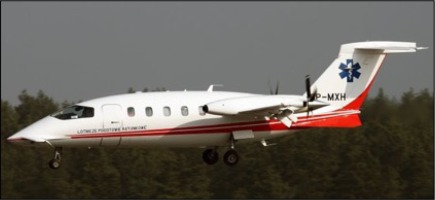
This aircraft is able to carry severely sick patients at a maximum speed of 745 km/h. On 20th April 2007, a second plane began service. both planes have been stationed at Warszawa Okęcie Airport since 2011.
Modernised Mi-2 plus helicopters were a temporary solution. The milieu of the Aviation emergency Service were aware of the necessity to replace the helicopters. because of the poor potential of Mi-2 plus in the mountains, the decision was made to open the base in Zakopane to tatry emergency Service which was equipped with a much better W-3 Sokół.
The first attempt to modernise the fleet was the purchase of Augusta A109, a modern rescue helicopter which started service on 2nd july 2005. This modern aircraft fulfilled pilots and doctors expectations as to the heMS system presently used. however, the medical compartment space, which was too small in comparison with eC-135, may have affected the lost tender for a new helicopter for LPR.
Modernisation of the helicopter fleet was started due to the Minister of healthcare of the time, Marek balicki. The Polish Sejm accepted a statute on 3rd May 2005 about creation of a multiannual programme „Replacement of the helicopters of the Independent Public healthcare Unit - Aviation emergency Service between 2005 and 2010”. The programme provided for replacement of helicopters fulfilling the requirements defined in the Statute of 3 july 2002 - Aviation Law (journal of Statutes no. 130, item 1112 with further amendments) and deployment of a flight simulator. The total funds for its implementation could not exceed 496 45 million PLN from the state budget calculated in the prices for 2004 (Statute of 3rd April 2005 about institution of multiannual programme „Replacement of the helicopters of the Independent Public healthcare Unit - Aviation emergency Service between 2005-2010” (journal of Statutes of 2005, no. 122, item 1022).
The tender announced for a new LPR helicopter was, apart from the tender for a multitask plane for military forces, the greatest financial enterprise of the kind in the last decades. Paweł Kłosiński describes this event in the article “LPR at the turning point” in “Skrzydlata Polska” magazine in no. 4/2012: “eurocopter with its model eC-135 was chosen as the contractor for delivery of 23 machines and one flight simulator. The first machine landed in Warszawa babice Airport on 10th September 2009. The other 22 helicopters were delivered by the end of 2010 (the transfer of the last 2 helicopters took place on 16th December 2010). The need to replace the helicopters arose, among other things, from the lack of a jAR-OPS 3 certificate for the Mi-2 plus helicopters used until then and the incompatibility of this equipment with the modern requirements and standards of aviation rescue. As a result of training and the need to familiarise oneself with new equipment, the first new LPR helicopters entered into service (heMS) on the cusp of spring and summer 2010, the last were turned over in spring 2011 (Kłosiński 2012).
The first eC-135 helicopter with registration mark SP-hXb was officially accepted into service on 10th September 2009. The ceremonial transition of the machine took place oat Warszawa- babice Airport. The last of the purchased 23 eurocopters was accepted at the base in Olsztyn on 26th April 2011 (Fig. 7).
The purchase of new aircraft was accompanied by establishment of a new training centre. The Aviation Centre created at Warszawa babice initially implemented theoretical and practical training on a Piaggio plane and Augusta helicopter. The eC-135 eurocopter’s first flyers were trained in Germany. In 2010, the Centre received an eC-135 P2+ Flight training Device level 3 flight simulator (called colloquially FtD eC-135) and since 2012, the training for a new type of helicopter has been possible. The interim training is currently conducted and new pilots joining the Aviation emercency Service are trained (https://lpr.com.pl ).
Modern equipment has placed new challenges before staff while offering greater possibilities. two newly formed bases were opened on 17th january 2013 in Łódź and on the next day in Suwałki. Three years later, 4 interim heMS bases started operation: 18 November 2016 in Ostrów Wielkopolski (at the time the base was being opened, the event was interrupted by a sudden distress call to a 4 year old girl); 22 November 2016 in Gorzów Wielkopolski; 24th November 2016 in Sokołów Podlaski; and 30th November 2013 in Ostrów Wielkopolski (https://lpr.com.pl). Due to eU resources and resources from self-government, they will be transformed into modern posts (on 18th November 2018, a new base was opened for use in Ostrów Wielkopolski) (https://lpr.com.pl ).
The specification of eC-135 P2+ allowed for the gradual introduction of the first round the clock duty hours. There are now 22 heMS bases in Poland - 21 all year round and 1 seasonal in Koszalin. (table 1.)
Table 1
Bases of Aviation Emergency Service Lotniczego Pogotowia Ratunkowego
Creation of new centres necessitated supplying them with extra helicopters. With the use of extra eU resources (eU funding was 85% of purchase value), it was possible to buy 4 new generation machines - eC 135 P3. The eU funding also covers the project for modifying 6 eC 135 P2+ helicopters in a configuration used by LPR for the eC-135 P3 model with other elements of the helicopter equipment unchanged, modernisation of 23 eC-135 P2+ helicopters for compatibility with NVG Night Vision Goggles requirements, modification of protective helmets for pilots and paramedics in order to adapt helmets to the standard that permits the fitting of night vision goggles, purchase of night vision goggles, and training of NVG instructors. Modification of 6 helicopters to model P3 will improve their performance and flight characteristics that are especially needed in high ground areas and over mountains. In May 2018, the intention to purchase 2 new planes for LPR was announced to replace the outworn Piaggio (htps://lpr.com.pl).
Technical details of eC-135 P2+ and P3 helicopters in order to compare are provided in the table below (table 2).
Table 2
Technical specification of helicopters - comparison EC-135 version P2+ i P3 (based on https://lpr.com.pl)
It is worth mentioning the main problem that appeared with the development of Aviation emergency Service which was the lack of pilots with an appropriate licence for heMS flights. Considering high skill requirements in training and landing, there was a ceremony to hand over two Robinson Raven R-44 II helicopters and 3 tecnamP2008jC MkII planes to LPR on 20th December 2018 in Warsaw. The aircraft will be used for extra training of pilots and also to ensure a proper amount of landing attempts to secure performance of the mission (https://lpr.com.pl ).
Conclusions
World War II hindered the development of Polish rescue aviation for a long time. Despite the lack of people and equipment and the destroyed infrastructure in the late 1940s, an effort was made to reconstruct the rescue system including sanitary aviation in Poland. Aeroclubs took over training and rescue flights were made on the Soviet PO-2 planes remodelled for sanitary purposes and American Piper L4 CUb planes purchased from the demobilised equipment. In time, the worn out aircraft was replaced with home production on Soviet licence CSS13 S13. Due to the efforts of tadeusz Więckowski- the creator of sanitary aviation in Poland before 1960, the first CSm-1 helicopters came into service. New technology started the development of sanitary aviation.
The Central team of Sanitary Aviation in Warsaw began its life in 1958 and became the supervising and coordinating unit of operations of the whole system of sanitary aviation. The staff in subordinate posts were continually trained and technical supervision was exercised as well. There were 16 posts operating across the country in the mid-1960s. The worn out S13 were taken out of use and replaced with the Soviet jak 12M. Apart from the already mentioned planes, Poland purchased several Aero 45 and Aero Ae 45 Super Aero. In 1962, L-200 Morava planes were bought. In the 1970s, replacement of helicopters for a more modern mass produced Mi-2 in WSK Świdnik commenced. L-410 turbolet planes were also purchased as well as 4 PZL M-20 Mewa planes. Martial Law on 13th December 1981 stopped the reform for a long time and only systemic changes after 1989 provided new opportunities to develop the rescue system.
On 16th May 2000, a new unit was created called Independent Public healthcare Aviation emergency Service. All Mi-2 helicopters were modernised and adapted to modern heMS standards. In May 2004, the Piaggio-180 Avanti plane was introduced. Due to the Statute of 3rd june 2005 regarding the replacement of LPR helicopters, the purchase of 23 modern eurocopter eC-135 was made to replace the gradually worn out Mi-2 from 10 September 2009. With the purchase of new aircraft, new LPR bases were created. There are currently 22 heMS bases in Poland, 21 all year round ones and 1 seasonal in Koszalin. The following programmes are being implemented to improve the heMS standards, among others: the purchase of 4 new eC-135 P3 machines, modernisation of 6 P2+ helicopters to version P3 and the implementation of the new night vision system.
In conclusion, the article looks at 74 years of history of Polish rescue aviation created from scratch after the war. It is worth mentioning that an important breakthrough was the introduction of helicopters into service, which ensured patients were reached faster. It should also be noted that the role of helicopters increased in comparison with planes in the aviation rescue system. Now there are 27 helicopters serving in the Aviation emergency Service while there are only 2 sanitary planes.


